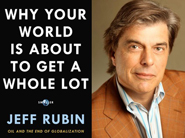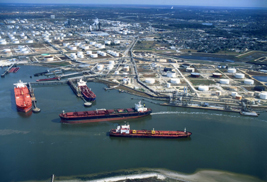$225 Oil by 2012 and the End of the Global Economy
 Jeff Rubin is not an oil alarmist—he doesn’t think that the world’s supply of crude will run out and cause resource wars and food shortages of apocalyptic proportions. In fact, he doesn’t even think the world’s supply of crude is running out at all. Rubin made this clear as he addressed the Business of Climate Change Conference in Toronto last September, opening his keynote address with the statement, “The world’s not running out of oil.” However, after milking the pause for a second or two, Rubin went on: “But it has already run out of oil it can afford to burn.”
Jeff Rubin is not an oil alarmist—he doesn’t think that the world’s supply of crude will run out and cause resource wars and food shortages of apocalyptic proportions. In fact, he doesn’t even think the world’s supply of crude is running out at all. Rubin made this clear as he addressed the Business of Climate Change Conference in Toronto last September, opening his keynote address with the statement, “The world’s not running out of oil.” However, after milking the pause for a second or two, Rubin went on: “But it has already run out of oil it can afford to burn.”Rubin, former head economist at CIBC World Markets, is often referred to as Canada’s top economist, largely because of his bold and accurate economic predictions: in 2000, he forecast that the price of crude would hit $50 per barrel within five years (it broke the $50 mark in 2004) and foresaw the huge price spike of 2008. He recently predicted that the price of crude would hit $100 again by the fourth quarter of this year.
His view of the future of oil and its role in civilization is just as startling as many prevailing theories within the peak oil community, but interestingly different from most that have come before.
As he explained at the Business of Climate Change Conference, Rubin envisions a world that has run out of cheap oil “not in the next 10 to 12 years, but in the next 10 to 12 months.” In his model, the beginning of the oil crisis is not marked by a sudden and extreme depletion of oil reserves, but oil prices that rise at an accelerating rate, driven by rapidly growing demand from the global economy (primarily from developing countries like China and India) and expanding development of expensive and energy-intensive non-conventional sources. According to Rubin, “since 2005 conventional oil supply has not grown, and may never grow again.” As the supply from conventional oil fields drops off, it will have to be replaced by supplies from dirtier, harder-to-process unconventional sources like the tar sands of Alberta, Canada. Because the processing of unconventional sources is so expensive, Rubin argues, the crude oil it produces will be more expensive. Combine higher baseline production costs with growing global demand and you get a huge increase in crude oil prices over a short period of time.As anecdotal evidence of the rapid depletion of conventional oil resources, Rubin pointed to frequent news stories on discoveries of major oil reservoirs in the Gulf of Mexico and elsewhere, in contrast with the lack of reporting on massive, decades-old oil fields drying up. According to Rubin, the world loses 4 million barrels per day of crude oil production every year, but we don’t hear much about it.
On the demand side, Rubin sees the global economy as the overarching driver of the world’s skyrocketing thirst for crude. Globalization has created a system of commerce that requires raw materials to be shipped from their places of origin to far-away industrial centers that produce consumer goods (everything from chicken wings to HD televisions), which are then shipped around the world again to consumers. Petroleum-based fuels power all of this transport, be it by sea vessel, airplane, or truck, Rubin reminded his audience. The problem with the global economy, he says, is that “it assumes that the cost of moving goods around the world is minimal or marginal.” And it was that assumption that allowed the sudden spike in crude oil prices in July of 2008 to trigger a global recession, Rubin said, emphasizing his belief that “the world’s biggest energy shock” and not the sub-prime mortgage crisis in the US caused the most severe economic downturn since the Great Depression.
In short, Rubin emphatically believes that two intensifying and antagonistic trends will cause a blast-off of crude oil prices in the next 15 months: exponentially-increasing demand for oil tied to the global economy and the ever-accelerating depletion of conventional (cheap) oil reserves.

Instead of calling for government action to avert the crisis-causing apex of these two trends, Rubin thinks the crisis will be addressed by local and individual action driven by market forces. “The prices needed to get unconventional oil out of the ground are the same prices that will get you off the road,” he explained. He elaborated by predicting that stratospheric oil prices would force consumers and producers alike to change behaviors that would eventually lead to a breakdown of the global economy and a return to local economies. After people stop driving, he suggested, they will begin to seek out cheaper goods, which will by then be made and distributed by nearby manufacturers and distributors, who are able to offer affordable prices thanks to lower fuel utilization and a resulting decrease in transport costs. “In a world of triple-digit oil prices, we will not be getting our food from China…we’re going to have to grow our own,” Rubin proclaimed.
So what if Rubin is right? What if his streak of correct predictions extends to this global bombshell? Under Rubin’s model, people should brace themselves for steep increases in gasoline, diesel, and heating oil prices over the next two years (after oil hits $100 this year, Rubin has said, it will reach $225 by 2012). Specifically, those preparations should amount to major cutbacks in consumption of and reliance on petroleum-based fuels—switching to ethanol or biofuels wherever possible, and reducing overall consumption of fuels by switching to more efficient vehicles and appliances are the most obvious first steps.
As is the case with all predictions, only time can prove Rubin’s right or wrong. In five years, Jeff Rubin will be definitively proven to be a genius or a paranoid dud. In the winter of 2015, if you find yourself sitting down in your biofuel-heated home to a dinner of locally produced food carried home on a bicycle while you marvel at the collapse of the global economy and shake your head at $15-a-gallon gasoline, remember, you heard it here first!
(Watch Rubin’s full speech at the Business of Climate Change Conference below)
You can return to the main Market News page, or press the Back button on your browser.

